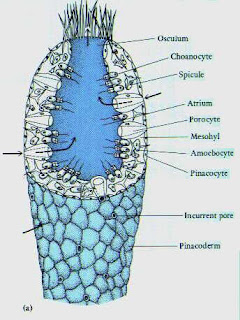 acelluar - without cells
acelluar - without cellsspongin fibres -flexible skeletal material made up of protein
spicules - supportive needles made up of calcium carbonate
invertebrates - an animal that lacks a backbone
Porifera - the phylum in which sponges are classified in (the Hexactinellida (glass sponges), the Demospongia, and the Calcarea (calcareous sponges))
collar cell - cells that line the interior of the sponge
osculum - a large hole through which water leaves the central cavity of a sponge
amebocyte - the sponge cell that builds spicules from calcium carbonate or silica
spongin - protein that makes up the skeleton of some sponges
gemmule - sphere-shaped collection of amebocytes surrounded by spicules which can grow into a new sponge
budding - asexual reproduction in sponges



